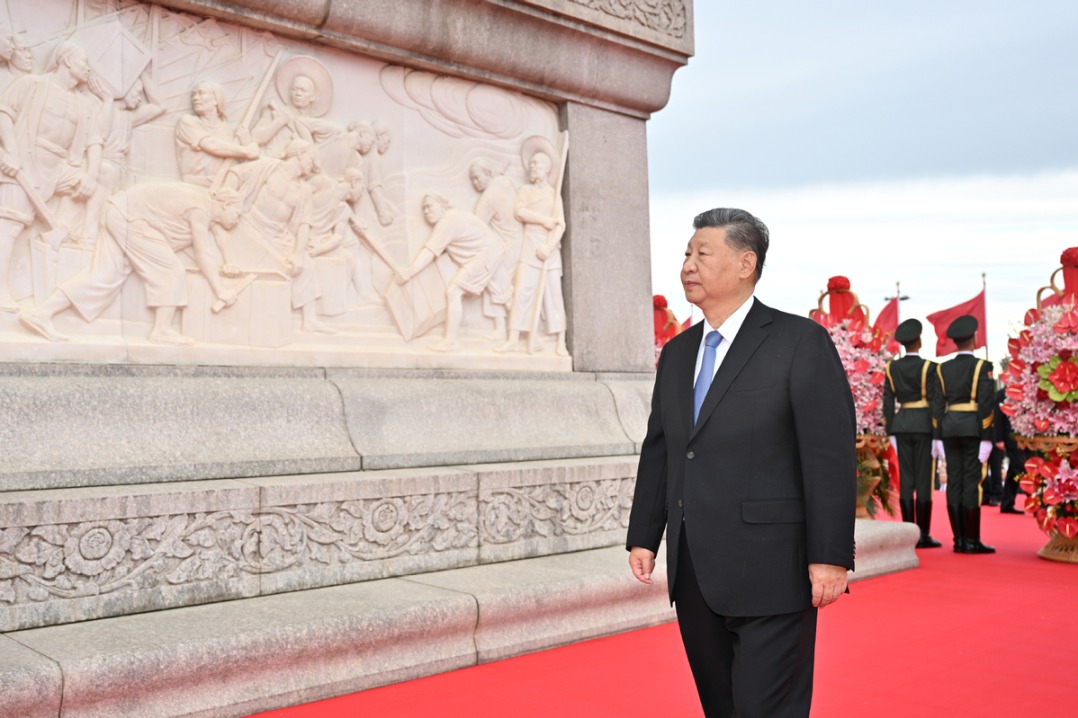Report: Critique of the South China Sea Arbitration Award
chinadaily.com.cn | Updated: 2024-07-11 11:01

CONTENTS
Abstract 1
Foreword 2
Part I: There is a territorial and maritime delimitation dispute between China and the Philippines in the South China Sea. 3
I. Origin and nature of the territorial issue between China and the Philippines in the South China Sea 3
II. The geographical framework between China and the Philippines in the South China Sea and the emergence of their maritime delimitation dispute 5
Part II:The Philippines unilaterally initiated the South China Sea arbitration case, and the Arbitral Tribunal exceeded its jurisdiction. 7
I. The disputes between China and the Philippines in the South China Sea should be resolved preferably through negotiation as chosen by the two parties by mutual agreement 7
II. The essence of the subject-matter of the arbitration is the territorial sovereignty over several islands, reefs and other features in the South China Sea, and constitute an integral part of the maritime delimitation over which the Arbitral Tribunal has no jurisdiction 8
Part III: The South China Sea Arbitration Award has serious flaws on such issues as historic rights, outlying archipelagos of continental states, island regime. 10
I. The Arbitral Tribunal erroneously denies China's historic rights in the South China Sea. 10
II. The Arbitration Tribunal erroneously invalidates the integrity of Nansha Qundao 10
III. The Arbitral Tribunal erroneously decides the status of some features in Nansha Qundao. 12
Part IV. The composition and representativeness of the South China Sea Arbitration Tribunal 13
Part V. China's position and proposals on the proper settlement of the disputes in the South China Sea 14
Abstract
It has been eight years since the South China Sea Arbitration Award was issued. China's official position of "non-acceptance, non-participation and non-recognition" is widely known to the international community. Given the current legal disputes and the dynamics in the South China Sea after it was issued, the Arbitration Award has an increasingly notable and negative impact on the proper settlement of the disputes, maintenance of peace and stability in the South China Sea, healthy development of the bilateral relations between China and other claimant countries, and the ongoing consultations on the Code of Conduct in the South China Sea (COC) between China and the ASEAN countries.
This report takes stock of the essence of the disputes over the South China Sea, conducts analysis and rebuttal of the jurisdiction of the South China Sea Arbitration Award, the treaty interpretation and application of the Arbitration Award and the determination of facts in respect of historic rights, the status of outlying archipelagos of continental countries and the status of island, and the representativeness of the Arbitral Tribunal, which further exposes to the international community the fallacies of the Arbitration Award and its damage to the international rule of law.
Foreword
Eight years have passed since the "South China Sea Arbitration Award" was issued. Instead of providing a solution to the disputes of the South China Sea, the award has made the already complicated South China Sea issue even more difficult to resolve. It has brought shocks to the United Nations Convention on the Law of the Sea (UNCLOS) as a balanced and serious "package agreement", and shaken the confidence of the States Parties in the proper use of the dispute settlement mechanism of UNCLOS in practice.
However, in recent years, there have been calls and actions both within and outside the region of the South China Sea for the award to be accepted as international law. Perhaps, it is out of misunderstanding by the ill-informed on third-party compulsory dispute settlement mechanisms, or misinterpretation by a small number of people on the rules of the law of the sea. But in the main, it reflects the attempts of certain countries in the region, based on false strategic judgments, to affirm the award and strengthen their unilateral claims, as well as the efforts by some forces outside the region to stir up trouble in the South China Sea by seeking to drive a wedge between China and ASEAN countries. All this will serve neither the sound development of the international rule of law nor enduring peace and order in the South China Sea.
The Arbitration Award is not a contribution to the international rule of law. Disregarding the basic fact that UNCLOS does not regulate matters of territorial sovereignty, the Arbitral Tribunal ignored China's position and opinions expressed through public channels, accepted the Philippines' claims intentionally designed to circumvent jurisdictional and other legal obstacles for it to initiate arbitral proceedings, and ruled on sovereignty over the islands and reefs in violation of the basic principles and the spirit of prudence and self-discipline that international judicial and arbitral institutions usually follow in their practice.
The Arbitration Award was not written for fairness and justice. The fundamental role of international dispute settlement mechanisms is to maintain international equity and justice. However, against the principle of the land dominates the sea in international law, the arbitral ruling attempted to deny China's territorial sovereignty, firm up the outcomes of the Philippines' illegal occupation, and endorse the Philippines' unilateral claims by misinterpreting and misapplying UNCLOS and customary law, with a long list of fallacies in interpretation and application, fact-finding and admissibility of evidence.
The Arbitration Award is not a panacea for dispute resolution. The goal of international judicial and arbitral institutions is to settle disputes effectively. However, this objective can not be reached by an ill-founded ruling issued by an arbitral tribunal without legitimacy that was politically motivated, manipulated and rejected by the other party based on sound and sufficient legal grounds. The South China Sea issue is so complex as it is related to so many countries, intertwines disputes on territorial sovereignty with issues of maritime delimitation, and involves historical, political, legal and other factors. It can by no means be resolved by a ruling of injustice that takes sides with one party against the other.
Part I: There is a territorial and maritime delimitation dispute between China and the Philippines in the South China Sea.
Nanhai Zhudao is China's inherent territory. The activities of the Chinese people in the South China Sea date back to over 2,000 years ago. China is the first to have discovered, named, explored and utilized Nanhai Zhudao and relevant waters, and the first to have continuously, peacefully and effectively exercised sovereignty and jurisdiction over them. China's sovereignty over Nanhai Zhudao and relevant rights in the South China Sea have been established in the long course of history and are solidly grounded in history and law.
I. Origin and nature of the territorial issue between China and the Philippines in the South China Sea
As neighbors facing each other across the sea, China and the Philippines have had close contact in history, and the two nations have enjoyed friendship over generations. However, since the 1970s, the Philippines has been illegally occupying some of the islands and reefs of Nansha Qundao, thus creating the issue of territorial sovereignty with China over some of the islands and reefs in the South China Sea. In addition, with the development of the international law of the sea, a maritime delimitation dispute also arose between the two countries on certain maritime areas of the South China Sea.
The territory of the Philippines is defined by a series of international treaties, including the 1898 Treaty of Peace between the United States of America and the Kingdom of Spain (the Treaty of Paris), the 1900 Treaty between the United States of America and the Kingdom of Spain for Cession of Outlying Islands of the Philippines (the Treaty of Washington), and the 1930 Convention between His Majesty in Respect of the United Kingdom and the President of the United States regarding the Boundary between the State of North Borneo and the Philippine Archipelago. China's Nanhai Zhudao is outside of the Philippines' territory. The current territorial issue between China and the Philippines in the South China Sea has its roots in the Philippines' invasion and illegal occupation of certain component features of China's Nansha Qundao. In the 1950s, the Philippines attempted to make moves on China's Nansha Qundao but eventually stopped because of China's firm opposition. Starting from the 1970s, the Philippines invaded and illegally occupied Mahuan Dao, Feixin Dao, Zhongye Dao, Nanyao Dao, Beizi Dao, Xiyue Dao, Shuanghuang Shazhou, and Siling Jiao of China's Nansha Qundao. In 1978, Philippine President Ferdinand Marcos signed Presidential Decree No. 1596 which designated some component features of China's Nansha Qundao and large areas of their surrounding waters as "Kalayaan Island Group", set up "Municipality of Kalayaan" and illegally included them in the Philippine territory. The Philippines has also enacted a series of national laws to lay its own claims of the territorial sea, exclusive economic zone and continental shelf, part of which conflicted with China's maritime rights in the South China Sea.
Since the 1980s, the Philippines has repeatedly taken moves that have complicated the disputes. For example, by building military facilities on the component features of China's Nansha Qundao it had illegally invaded and occupied, the Philippines attempted not only to establish a fait accompli of permanent occupation but also to expand its illegal seizure. The Philippines has repeatedly infringed China's maritime rights in an attempt to expand and entrench its illegal claims in the South China Sea. These moves have grossly violated China's sovereignty as well as its maritime rights in the South China Sea. Since 1997, the Philippines has also harbored territorial pretensions to China's Huangyan Dao and attempted to occupy it illegally. On 17 February 2009, the Philippine Congress passed Republic Act No. 9522, to illegally include China's Huangyan Dao and some component features of Nansha Qundao into the Philippines' territory.
The Philippines has concocted many excuses to cover up its invasion and illegal occupation of some islands and reefs of China's Nansha Qundao in order to pursue its territorial pretensions. For instance, it claims that: "Kalayaan Island Group" is not part of Nansha Qundao but terra nullius; Nansha Qundao became "trust territory" after the end of the Second World War; the Philippines has occupied Nansha Qundao because of "contiguity or proximity" and out of "national security" considerations; "some islands and reefs of Nansha Qundao are located in the exclusive economic zone and continental shelf of the Philippines"; the Philippines' "effective control" over the islands and reefs has become the "status quo" that cannot be changed.
The Philippines' territorial claim over part of Nansha Qundao is groundless from the perspectives of both history and international law.
First, Nansha Qundao has never been part of the Philippine territory. The territorial scope of the Philippines has already been defined by a series of international treaties. The United States, administrator of the Philippines in the colonial era, was clearly aware of these facts.
Second, the claim that "Kalayaan Island Group" is "terra nullius" discovered by the Philippines is groundless. The Philippines claims that its nationals "discovered" the islands in 1956, and uses this as an excuse to single out some islands and reefs of China's Nansha Qundao and name them "Kalayaan Island Group". This is an attempt to create confusion over geographical names and concepts and dismember China's Nansha Qundao. As a matter of fact, the geographical scope of Nansha Qundao is clear, and the so-called "Kalayaan Island Group" is part of China's Nansha Qundao. Nansha Qundao has long been an integral part of China's territory and is by no means "terra nullius".
Third, Nansha Qundao is not a "trust territory" either. The Philippines claims that after the Second World War, Nansha Qundao became a "trust territory", the sovereignty over which was undetermined. This claim finds no support in law or reality. The post-WWII trust territories were all specifically listed in the international treaties or the documents of the United Nations Trusteeship Council. Nansha Qundao was never included in them and was thus not a trust territory at all.
Fourth, neither "contiguity or proximity" nor national security is a basis under international law for acquiring land or insular territory. Many countries have territories far away from their metropolitan areas, in some cases even very close to the shores of other countries. Furthermore, it is just absurd to invade and occupy the territory of other countries on the grounds of national security.
Fifth, the Philippines claims that some islands and reefs of China's Nansha Qundao are located within its exclusive economic zone and continental shelf and therefore should fall under its sovereignty or form part of its continental shelf. This claim seeks to deny China's territorial sovereignty on the basis of maritime limits provided for under UNCLOS, runs counter to the principle of international law that "the land rules the sea", and is totally incompatible with the purposes and objectives of UNCLOS. Littoral states may not use the assertion of maritime rights as a justification for denying or infringing upon the territorial sovereignty of another state.
Sixth, the Philippines' so-called "effective control" on the basis of its illegal seizure is null and void. The international community does not recognize "effective control" created through occupation by force. The Philippines' "effective control" is mere occupation by naked use of force of some islands and reefs of China's Nansha Qundao. Such occupation violates the Charter of the United Nations and the basic norms governing international relations and is unequivocally prohibited by international law. This so-called "effective control" based on illegal seizure cannot change the basic fact that Nansha Qundao is China's territory. China firmly opposes any attempt to treat the seizure of some islands and reefs of China's Nansha Qundao as a so-called "fait accompli" or "status quo".
II. The geographical framework between China and the Philippines in the South China Sea and the emergence of their maritime delimitation dispute
At the heart of the disputes between China and the Philippines in the South China Sea lies the territorial issue over certain component features. This issue has a significant impact on their claims to maritime rights and interests in the South China Sea. China's claims to maritime rights and interests based on Nanhai Zhudao overlap with the Philippines' claims based on the Philippine Islands. In addition, the Philippines has made illegal claims to China's Huangyan Dao of Zhongsha Qundao and certain component features of Nansha Qundao and misinterpreted the UNCLOS and presented various spurious assertions on the legal status of some individual component features, complicating the conflict of their maritime rights and the situation of maritime delimitation.
China and the Philippines are neighbors facing each other across the sea, and "States with opposite or adjacent coasts" as referred to in Articles 74 and 83 of UNCLOS. China's Nanhai Zhudao consist of Dongsha Qundao, Xisha Qundao, Zhongsha Qundao and Nansha Qundao. These archipelagos each include, among others, islands, reefs, shoals and cays of various numbers and sizes. China's claims to maritime entitlements have always been based on each archipelago as a unit. Among these archipelagos, Zhongsha Qundao and Nansha Qundao face the Philippines across the sea, with less than 200 nautical miles to the coast of the Philippine Islands. Obviously, this forms a geographical framework of maritime delimitation and gives rise to the fact of maritime delimitation between China and the Philippines in the South China Sea, with their claims of continental shelf and exclusive economic zone overlapping. Moreover, from the mainland, Hainan Dao, Xisha Qundao and Dongsha Qundao, China may claim a continental shelf beyond 200 nautical miles in the South China Sea.
China and the Philippines both have claimed maritime rights and entitlements in the South China Sea. On the basis of the practice of the Chinese people and the Chinese government in the long course of history and the position consistently upheld by successive Chinese governments, and pursuant to China's national law and under international law, including the 1958 Declaration of the Government of the People's Republic of China on China's Territorial Sea, the 1992 Law of the People's Republic of China on the Territorial Sea and the Contiguous Zone, the 1998 Law of the People's Republic of China on the Exclusive Economic Zone and the Continental Shelf, the 1982 United Nations Convention on the Law of the Sea, and the 1996 Decision of the Standing Committee of the National People's Congress of the People's Republic of China on the Ratification of the United Nations Convention on the Law of the Sea, Nanhai Zhudao shall have internal waters, territorial sea, contiguous zone, exclusive economic zone and continental shelf. In addition, China has historic rights in the South China Sea.
The Philippines proclaimed its internal waters, archipelagic waters, territorial sea, exclusive economic zone and continental shelf according to, among others, the Philippines' Republic Act No. 387 of 1949, Republic Act No. 3046 of 1961, Republic Act No. 5446 and Presidential Proclamation No. 370 of 1968, Presidential Decree No. 1599 of 1978, and Republic Act No. 9522 of 2009. In the South China Sea, the Philippines has claimed an exclusive economic zone and continental shelf from the coast of the Philippine Islands.
The above-mentioned maritime rights and entitlements claimed by the two States overlap, giving rise to a maritime delimitation dispute.
























